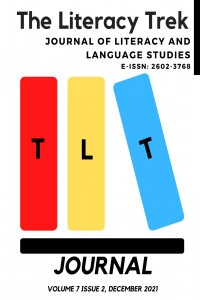Abstract
References
- Bakhtin, M. (1984). Rabelais and his world. Indiana University Press.
- Carter, A. (1982). The passion of new eve. Virago.
- Carter, A. (1998). Notes from the Front Line. In J. Smith, Shaking a leg: Collected writings (pp. 26-30). Penguin Books.
- Johnson, H. L. (1997). Unexpected geometries: Transgressive symbolism and the transsexual subject in Angela Carter’s The Passion of New Eve. In J. Bristow & T. L. Broughton (Eds). The Infernal Desires of Angela Carter: Fiction, Femininity, Feminism (pp. 166-184). Addison Wesley Longman.
- Johnson, H. L. (2000). Textualising the double-gendered body: Forms of the grotesque in The Passion of New Eve. A. Easton (Ed). New casebooks: Angela Carter (pp. 127-135). Macmillan Press.
- Kerchy, A. (2008). Body texts in the novels of Angela Carter: Writing from a corporeagraphic point of view. The Edwin Mellen Press.
- Kerchy, A. (2009). Bodies that do not fit: sexual metamorphoses, re-embodied identities and cultural crisis in contemporary transgender memoirs. In S. Coelsch-Foisner & M. Fernandez Morales. The human body in contemporary literatures in English: Cultural and political implications (pp. 129-150). Peter Lang.
- Lokke, K. E. (1988). Bluebeard and the bloody chamber: The grotesque of self-assertion. A Journal of Women Studies, 10(1), 7-12.
- Pitchford, N. (2002). Tactical writings: Feminist postmodernism in the novels of Kathy Acker and Angela Carter, Bucknell University Press.
- Russo, M. (1988). Female grotesques: Carnival and theory. In T. de Lauretis. Feminist studies/critical studies (pp.213-229). The Macmillan Press.
- Tonkin, M. (2012). Angela Carter and decadence: Critical fictions/fictional critiques. Palgrave Macmillan.
- Yeandle, H. (2017). Angel Carter and western philosophy. Palgrave Macmillan.
Abstract
Angela Carter’s subversive narrative techniques help her establish an authentic narrative atmosphere in which she is able to demythologise and dephilosophise traditional codes. Among these techniques, the grotesque is considered to be the most groundbreaking one through which Carter rejects the classical body concept. By the grotesque, Carter is able to represent her sense of parodic and ironic depiction of the female body whose perverse and subversive qualities demolish “an ideal woman-image.” Therefore, it is possible to see the grotesque characteristics in Carter’s The Passion of New Eve. This study hereby explores the ‘grotesque’ as one of the major literary ways of the Carterian expression and explains how the ideal woman image is demolished when it passes through the filter of Carter’s politics of the grotesque in her The Passion of New Eve.
References
- Bakhtin, M. (1984). Rabelais and his world. Indiana University Press.
- Carter, A. (1982). The passion of new eve. Virago.
- Carter, A. (1998). Notes from the Front Line. In J. Smith, Shaking a leg: Collected writings (pp. 26-30). Penguin Books.
- Johnson, H. L. (1997). Unexpected geometries: Transgressive symbolism and the transsexual subject in Angela Carter’s The Passion of New Eve. In J. Bristow & T. L. Broughton (Eds). The Infernal Desires of Angela Carter: Fiction, Femininity, Feminism (pp. 166-184). Addison Wesley Longman.
- Johnson, H. L. (2000). Textualising the double-gendered body: Forms of the grotesque in The Passion of New Eve. A. Easton (Ed). New casebooks: Angela Carter (pp. 127-135). Macmillan Press.
- Kerchy, A. (2008). Body texts in the novels of Angela Carter: Writing from a corporeagraphic point of view. The Edwin Mellen Press.
- Kerchy, A. (2009). Bodies that do not fit: sexual metamorphoses, re-embodied identities and cultural crisis in contemporary transgender memoirs. In S. Coelsch-Foisner & M. Fernandez Morales. The human body in contemporary literatures in English: Cultural and political implications (pp. 129-150). Peter Lang.
- Lokke, K. E. (1988). Bluebeard and the bloody chamber: The grotesque of self-assertion. A Journal of Women Studies, 10(1), 7-12.
- Pitchford, N. (2002). Tactical writings: Feminist postmodernism in the novels of Kathy Acker and Angela Carter, Bucknell University Press.
- Russo, M. (1988). Female grotesques: Carnival and theory. In T. de Lauretis. Feminist studies/critical studies (pp.213-229). The Macmillan Press.
- Tonkin, M. (2012). Angela Carter and decadence: Critical fictions/fictional critiques. Palgrave Macmillan.
- Yeandle, H. (2017). Angel Carter and western philosophy. Palgrave Macmillan.
Details
| Primary Language | English |
|---|---|
| Journal Section | Literary articles & essays |
| Authors | |
| Publication Date | December 17, 2021 |
| Submission Date | September 18, 2020 |
| Published in Issue | Year 2021 Volume: 7 Issue: 2 |
 The content is licensed under a Creative Commons Attribution-NonCommercial 4.0 International License. Copyright rests with the author; The Literacy Trek must be referred properly.
The content is licensed under a Creative Commons Attribution-NonCommercial 4.0 International License. Copyright rests with the author; The Literacy Trek must be referred properly.


